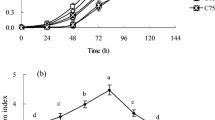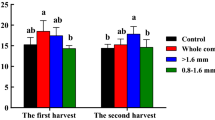Abstract
We investigated how the application of composted sewage sludge to tailings affects the physiological response of woody plants growing on abandoned coal-mining sites. Twenty seedlings ofBetula schmidtii were transplanted to pots containing various combinations of artificial soil plus nursery soil, tailings, composted soil, or tailings amended with composted soil. Dry weights, shoot to root ratios, relative growth rates (RGR), chlorophyll content and fluorescence, and carbohydrate concentrations were assessed at the end of the experiment. Growth responses differed significantly among soil types. For example, dry weights were greatest for seedlings grown in composted soil and smallest for plants raised in pure tailings. Shoot to root ratios were higher for seedlings in composted soil compared with those in either tailings or nursery soil. Leaf chlorophyll content was twice as high for seedlings from composted soil than for those in the nursery soil or tailings; chlorophyll fluorescence (Fv/Fm) was lower for seedlings in either nursery soil or tailings than for those in composted soil. In contrast, plants grown in either nursery soil or tailings had higher starch concentrations in their stems, whereas the carbohydrate allocation of seedlings in composted soil was highest in the leaves, followed by stems and roots. Overall, the carbohydrate content was highest in the leaves, except for seedlings treated with tailings. Therefore, we believe that composted soil can improve the physiological and biochemical properties of trees growing in tailings when appropriate nutrients are supplemented.
Similar content being viewed by others
Literature cited
Baker AJM, McGrath SP, Sidoli CMD, Reeves RD (1994) The possibility of in situ heavy metal decontamination of polluted soils using crops of metal-accumulating plants. Res Cons Recycl 11: 41–49
Baker NR (1991) A possible role for photosystem II in environmental perturbations of photosynthesis. Physiol Plant 81: 563–570
Bamhisel RL (1988) Fertilization and management reclaimed lands.In LR Hossner, ed, Reclamation of Surface-mined Lands, Vol 2. CRC Press, Boca Raton, FL, pp1–16
Butler WL, Kitajima M (1975) Fluorescence quenching in photosystem II of chloroplasts. Biochim Biophys Acta 376: 116–125
Cannell MGR, Sheppard LJ, Milne R (1988) Light use efficiency and woody biomass production of poplar and willow. Forest 61: 125–136
Chapin FS III (1991) Effects of multiple environmental stresses on nutrient availability and use.In HA Mooney, WE Winner, EJ Pell, eds, Response of Plants to Multiple Stresses. Academic Press, San Diego, pp 67–88
Demmig B, Bjorkman O (1987) Comparison of the effect of excessive light on chlorophyll fluorescence (77K) and photon yield of OO2 evolution in leaves of higher plants. Planta 171: 171–184
Dewar RC (1993) A root-shoot partitioning model based on carbon-nitrogen-water interaction and Munch phloem flow. Func Ecol 7: 356–369
Ericsson T, Kahr M (1995) Growth and nutrition of birch seedlings at varied relative addition rates of magnesium. Tree Physiol 15: 85–93
Ericsson T, Rytter L, Vapaavuori E (1996) Physiology of carbon allocation in trees. Biomass Bioenergy 11: 115–127
Gao L, Miao Z, Bai Z, Zhou X, Zhao J, Zhu Y (1998) A case study of ecological restoration at the Xiaoyi Bauxite Mine, Shanxi Province, China. Ecol Eng 11: 221–229
Hendry GAF, Price AH (1993) Stress indicators: Chlorophylls and carotenoids.In GAF Hendry, JP Grime, eds, Methods in Comparative Plant Ecology: A Laboratory Manual. Chapman and Hall, pp 148–152
Hossner LR, Hons FM (1992) Reclamation of mine tailings.In BA Stewart, ed, Advances in Soil Science, Vol 17. Springer-Verlag, New York.
Hu Z (2000) Policy and executing measures/technology for restoration and revegetation of the abandoned coalmine lands in China. International Symposium for the Development of Environmental Restoration and Revegetation Technology in the Abandoned Coal-Mine Lands. Korea Forest Research Institute. pp 57–90
Ingestad T (1979) Nitrogen stress in birch seedlings. II. N, K, P and Mg nutrition. Physiol Plant 45: 149–157
Lee J-C, Han S-H, Jang S-S, Lee J-H, Kim P-G, Hur J-S, Yum K-J (2002) Selection of indigenous tree species for the revegetation of the abandoned coal mine lands in Tae-back Area. Kor J Agr Forest Meteorol 4: 86–94
Paynter VA, Reardon JC, Shelburne VB (1992) Changing carbohydrate profiles in shortleaf pine (Pinus echinata) after prolonged exposure to acid rain and ozone. Can J Forest Res 22: 1556–1561
Pichtel J, Salt CA (1998) Vegetative growth and trace metal accumulation on metalliferous wastes. J Env Qual 27: 618–642
Tester CF (1990) Organic amendments effects on physical and chemical properties of a sandy soil. Soil Sci Soc Amer J 54: 827–831
Thornley JHM (1972) A balanced quantitative model for root:shoot ratios in vegetative plants. Ann Bot 36: 431–441
Voeller PJ, Zamora BA, Harsh J (1998) Growth response of native shrubs to acid mine spoil and to proposed soil amendments. Plant Soil 198: 209–217
Wilden R, Schaaf W, Hüttl RF (2001) Element budgets of two afforested mine sites after application of fertilizer and organic residues. Ecol Eng 17: 253–273
Woo B-M (2000) Evaluation for rehabilitation countermeasures of coal-mined spoils and denuded lands. J Kor Env Res Reveg Tech 3: 24–34
Yum K-J, Kim P-G, Park EW (1999) Effects of sewage sludge application for restoration of abandoned mine areas. J Kor Soc Env Eng 21: 2329–2340
Author information
Authors and Affiliations
Corresponding author
Rights and permissions
About this article
Cite this article
Han, SH., Lee, JC., Jang, SS. et al. Composted sewage sludge can improve the physiological properties ofBetula schmidtii grown in tailings. J. Plant Biol. 47, 99–104 (2004). https://doi.org/10.1007/BF03030638
Received:
Accepted:
Issue Date:
DOI: https://doi.org/10.1007/BF03030638




